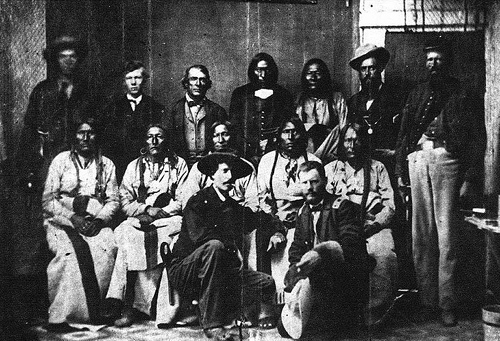Memorial to 1864 Indian massacre victims opens in Colorado

Black Kettle (seated center) and other Cheyenne chiefs conclude successful peace talks with Major Edward W. Wynkoop (kneeling with hat) at Fort Weld, Colorado, in September 1864. Based on the promises made at this meeting, Black Kettle led his band back to the Sand Creek reservation, where they were massacred in late November. Photo courtesy National Archives.
The Sand Creek Massacre National Historic site, 160 miles southeast of Denver in Kiowa County, is meant to pay tribute to those killed in the shameful Nov. 29, 1864, attack. Seeking revenge for the killings of several settlers by Indians, 700 militia members slaughtered nearly everyone in the village. Most were women or children.
Descendants of the victims were among at least 500 people at the dedication ceremony. A mock village of a dozen tepees was set up in a stand of cottonwood trees along the creek, where historians believe the slaughter took place.
After a prayer and a blessing for the troops in Iraq, members of the Cheyenne and Arapaho tribes chanted and played drums. Tribal members who are soldiers wore their uniforms as well as headdresses when they carried in the U.S. and other flags.
Eyewitness accounts of the attack include a letter from Lt. Joseph Cranmer: “A squaw ripped open and a child taken from her. Little children shot while begging for their lives.” Tribal descendants claim they can still hear the children cry when they visit the site.
Then-Sen. Ben Nighthorse Campbell of Colorado, a member of the Northern Cheyenne tribe, sponsored the bill creating the national historic site. He said he slept Friday night along the creek “to get a picture” of what the people saw before the attack.
The attack was recognized almost immediately as criminal. Congress condemned it, and President Lincoln fired territorial Gov. John Evans. Witnesses told Congress the victims weren't hostile.
The attack triggered many retaliatory attacks by Indians, including the Battle of the Little Bighorn, where Lt. Col. George Armstrong Custer was killed.
For more information on the Sand Creek Massacre and the new historical site click here.


0 Comments:
Post a Comment
<< Home